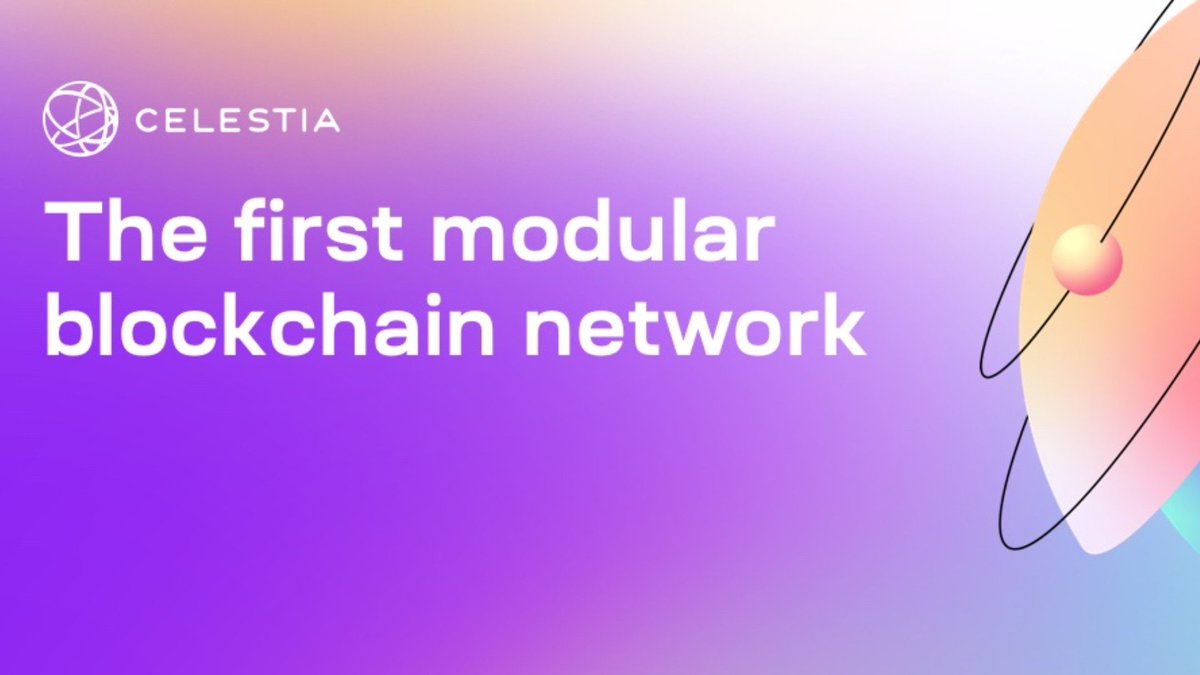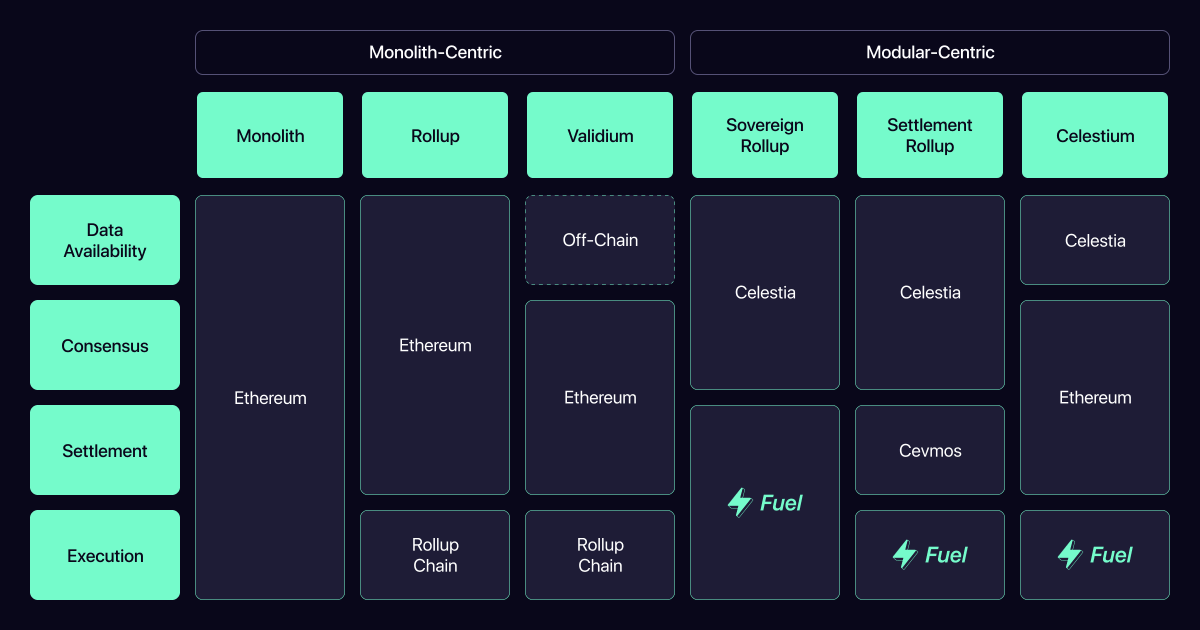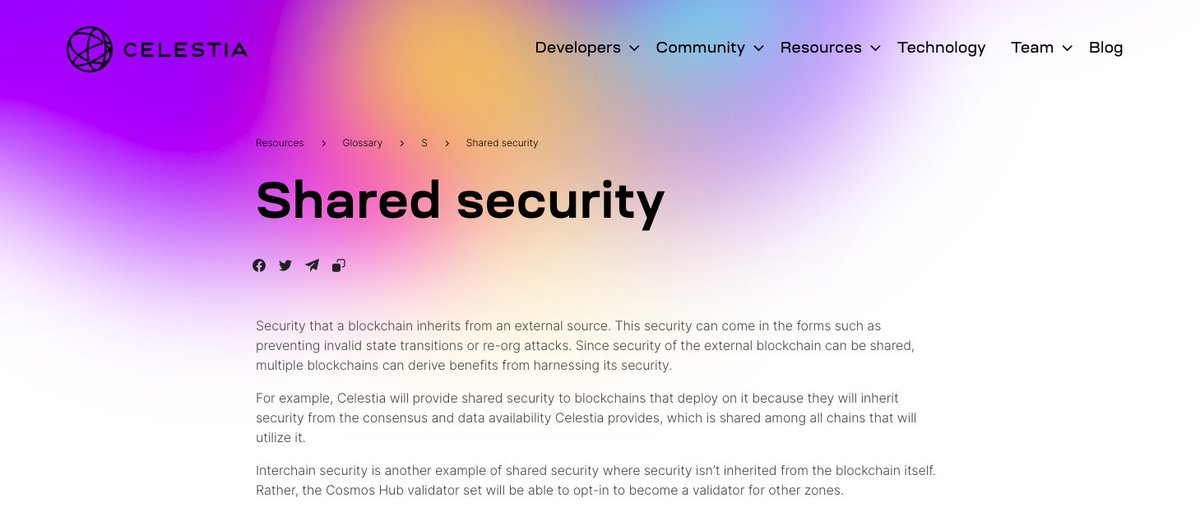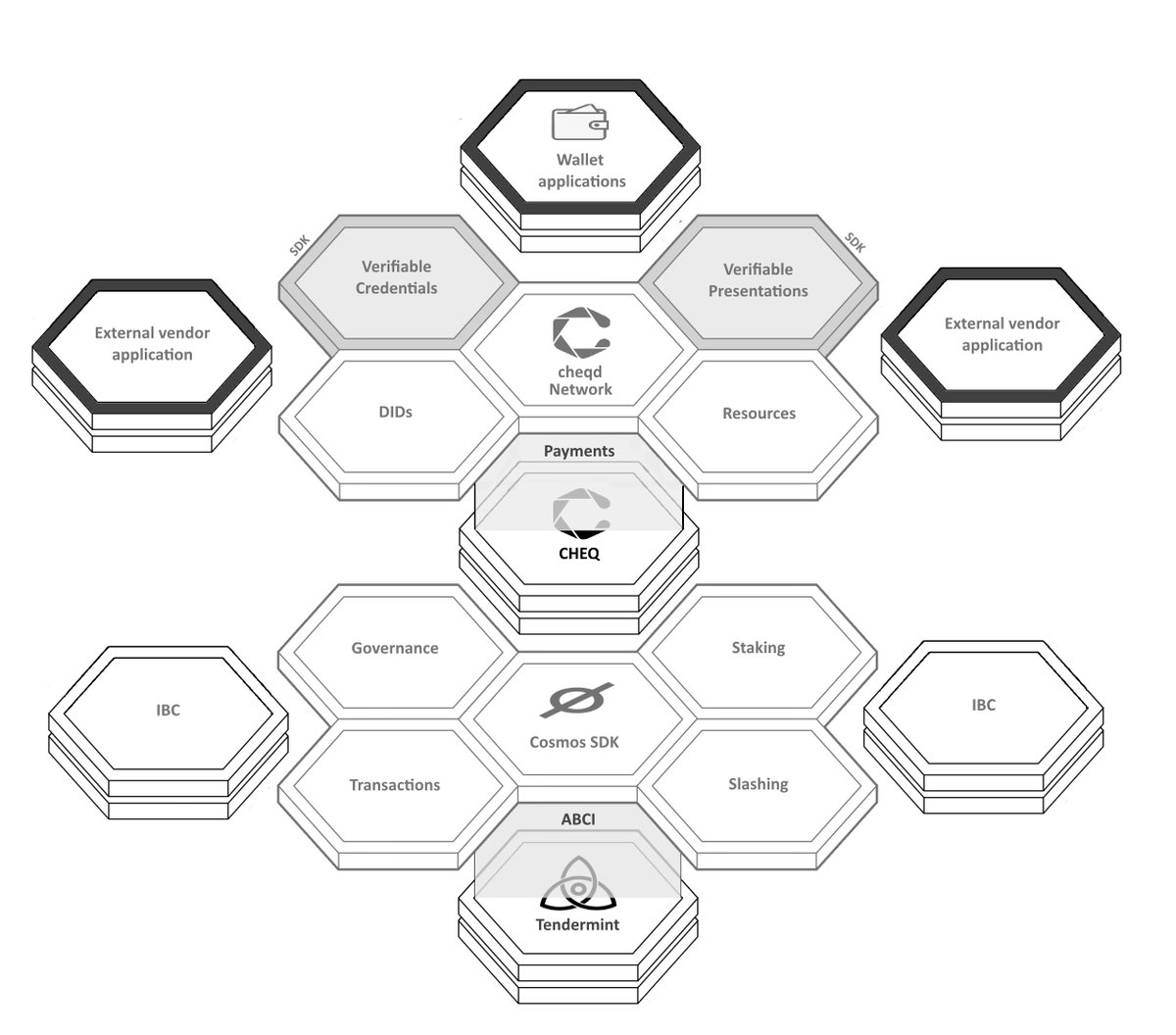
Celestia — the first modular blockchain network — is one of the most anticipated chains launching in 2023.
What is it? Why all the excitement? And how can Celestia potentially free us from a never ending list of L2, app & consumer chains?
A 🧵👇
1/24
@CelestiaOrg $TIA
What is it? Why all the excitement? And how can Celestia potentially free us from a never ending list of L2, app & consumer chains?
A 🧵👇
1/24
@CelestiaOrg $TIA

Why Celestia makes sense?
New L1 blockchains are spawning left, right and center.
We don't really need all these L1s.
Tech-wise, most of them are non-original copy-cats. They cannot attract volume, liquidity or validators, which means low security.
2/
New L1 blockchains are spawning left, right and center.
We don't really need all these L1s.
Tech-wise, most of them are non-original copy-cats. They cannot attract volume, liquidity or validators, which means low security.
2/

Celestia is taking a different approach.
What if literally anyone could launch their own blockchain using Celestia, without the currently excessive costs associated with doing that?
What if all chains can benefit from shared security using an existing set of validators?
3/
What if literally anyone could launch their own blockchain using Celestia, without the currently excessive costs associated with doing that?
What if all chains can benefit from shared security using an existing set of validators?
3/

This is what Celestia aims for, while stille maintaining full sovereignty over a new chain, even though it's built on top of Celestia.
Parallel processing? You got it.
Different execution rules? Go for it.
New staking rewards? Just do it.
4/
Parallel processing? You got it.
Different execution rules? Go for it.
New staking rewards? Just do it.
4/

Celestia is the first modular blockchain network, allowing devs to easily deploy their own blockchain on top of Celestia, without having to create their own consensus network.
Importantly, Celestia does not execute transactions, they only order and publish them. This is key.
5/
Importantly, Celestia does not execute transactions, they only order and publish them. This is key.
5/

Contrary to a monolithic blockchain (eg. $ETH, $SOL, $BTC etc), the four main blockchain functions are spread across various layers:
⛓️ Execution
⛓️ Settlement
⛓️ Consensus
⛓️ Data Availability
Each layer has its own main thing that it takes care of.
6/
⛓️ Execution
⛓️ Settlement
⛓️ Consensus
⛓️ Data Availability
Each layer has its own main thing that it takes care of.
6/

The core innovation with Celestia is the separation of consensus from execution.
Each layer is specialized in a couple smaller functions, unlike a typical blockchain where there is one layer that has to take care of everything.
Combining the best of both worlds.
7/
Each layer is specialized in a couple smaller functions, unlike a typical blockchain where there is one layer that has to take care of everything.
Combining the best of both worlds.
7/

Instead of deploying L2 chain, consumer chains, side chains and what have you, with Celestia, each blockchain gets their own execution and smart contract layer. Celestia handles the rest.
Benefits of doing so?
👉 Scalability
👉 No congestion
👉 Shared security
👉 Sovereignty
8/
Benefits of doing so?
👉 Scalability
👉 No congestion
👉 Shared security
👉 Sovereignty
8/

Scalability
Core functions are spread across different layers. Celestia doesn't have to execute transactions themselves or take care of smart contracts.
By not having to execute tx's or take care of smart contracts, Celestia can focus entirely on data availability.
9/
Core functions are spread across different layers. Celestia doesn't have to execute transactions themselves or take care of smart contracts.
By not having to execute tx's or take care of smart contracts, Celestia can focus entirely on data availability.
9/

No congestion
There is no competition for block space between chains deployed on Celestia since they do their own tx executions.
In a monolithic blockchain like #Ethereum, all dapps compete to get their transactions processed, which is why you see gas fee spikes often.
10/
There is no competition for block space between chains deployed on Celestia since they do their own tx executions.
In a monolithic blockchain like #Ethereum, all dapps compete to get their transactions processed, which is why you see gas fee spikes often.
10/

Shared Security
Launching your own L1 is expensive and time-consuming to attract enough validators.
Failing to do so compromises security.
With Celestia, there is shared security between all chains launched on top of it, similar to #Polkadot and #cosmos ICS.
11/
Launching your own L1 is expensive and time-consuming to attract enough validators.
Failing to do so compromises security.
With Celestia, there is shared security between all chains launched on top of it, similar to #Polkadot and #cosmos ICS.
11/

Sovereignty and customizability
Apps on Celestia – unlike those on L1’s like #Ethereum, #Solana and other smart contract networks – are not subject to a set of rules that they have to adhere to.
Celestia chains are sovereign, like app chains in #cosmos.
12/
Apps on Celestia – unlike those on L1’s like #Ethereum, #Solana and other smart contract networks – are not subject to a set of rules that they have to adhere to.
Celestia chains are sovereign, like app chains in #cosmos.
12/

So building on Celestia is like deploying an app chains on Cosmos?
Yes and no.
Celestia is powering rollups, not chains.
The do so by solving the ‘Data Availability‘ problem.
This is the core to Celestia's breakthrough.
13/
Yes and no.
Celestia is powering rollups, not chains.
The do so by solving the ‘Data Availability‘ problem.
This is the core to Celestia's breakthrough.
13/

What holds back rollups built on monolithic chains like #Ethereum is data availability.
Ethereum has a certain capacity for data availability. If that data availability would be at a higher capacity, rollups could really show us what they’re made of. But they can't.
14/
Ethereum has a certain capacity for data availability. If that data availability would be at a higher capacity, rollups could really show us what they’re made of. But they can't.
14/

Celestia has two novel scaling capabilities that empower their data availability later:
1) Nodes can verify data availability without having to download an entire block
2) Execution and settlement layers on Celestia can download transactions that are only relevant to them.
15/
1) Nodes can verify data availability without having to download an entire block
2) Execution and settlement layers on Celestia can download transactions that are only relevant to them.
15/

Data availability is also important for the security and decentralization of the network.
With the techniques described above, the average user of the network can download small portions of the available data to check if the data has indeed been published.
16/
With the techniques described above, the average user of the network can download small portions of the available data to check if the data has indeed been published.
16/

It's important that the average users can help validate the network/data, because this makes it possible to verify large blocks at a low cost.
Thus, improving scalability.
17/
Thus, improving scalability.
17/

This is opposite of most blockchains, where users have to download all the data to check if it is available. This prices out the average user, which negatively impacts scalability.
Lower barriers -> more users -> more collective power -> more scalability -> higher security
18/
Lower barriers -> more users -> more collective power -> more scalability -> higher security
18/

So what about all the existing rollups like Arbitrum and Optimism?
There is a huge potential that Celestia could possible have on currently existing layer 2’s.
Namely, through their ‘Quantum Gravity Bridge’ – a Celestia to Ethereum data availability (DA) bridge.
19/
There is a huge potential that Celestia could possible have on currently existing layer 2’s.
Namely, through their ‘Quantum Gravity Bridge’ – a Celestia to Ethereum data availability (DA) bridge.
19/

With Celestia comes Celestiums:
“A Celestium is an #Ethereum L2 chain that uses Celestia for data availability, but uses Ethereum for settlement and dispute resolution.”
With Celestiums, Celestia can provide existing L2's on other ecosystems with a data availability layer!
20/
“A Celestium is an #Ethereum L2 chain that uses Celestia for data availability, but uses Ethereum for settlement and dispute resolution.”
With Celestiums, Celestia can provide existing L2's on other ecosystems with a data availability layer!
20/
So what about the $TIA token?
What we know so far?
👉 It will be PoS so users stake the token to help validate the network
👉 Main use case is to pay gas fees
👉 Celestia will have a fee-burn mechanism similar to EIP-1559 on #Ethereum
21/
What we know so far?
👉 It will be PoS so users stake the token to help validate the network
👉 Main use case is to pay gas fees
👉 Celestia will have a fee-burn mechanism similar to EIP-1559 on #Ethereum
21/

Teams are already starting to build on Celestia, most notably @dymensionXYZ that is building a platform for creating rollups.
We hosted on a space Dymension and wrote a thread on their work below 👇
22/
We hosted on a space Dymension and wrote a thread on their work below 👇
22/
https://twitter.com/CosmosClub_/status/1552926036282802177
It's worth mentioning that we also have $TIA on our 2023 shopping list, which you find here:
23/
23/
https://twitter.com/CosmosClub_/status/1625829867500576769
If you want to read more about Celestia and modular blockchains we highly encourage you to read this piece from @Maven11Capital
24/
maven11.substack.com/p/the-modular-…
24/
maven11.substack.com/p/the-modular-…
If you've found this thread helpful, please like or retweet.
Follow @CosmosClub_ for more threads like this.
Subscribe to our podcast on Spotify and YouTube channel on all things $ATOM $OSMO $JUNO $KUJI $EVMOS $TORI $AKT $STARS $SWTH $UMEE & $SCRT.
linktr.ee/cosmosclub_
Follow @CosmosClub_ for more threads like this.
Subscribe to our podcast on Spotify and YouTube channel on all things $ATOM $OSMO $JUNO $KUJI $EVMOS $TORI $AKT $STARS $SWTH $UMEE & $SCRT.
linktr.ee/cosmosclub_
• • •
Missing some Tweet in this thread? You can try to
force a refresh








